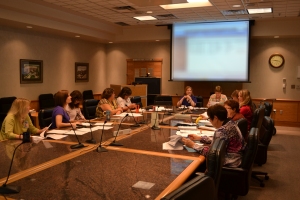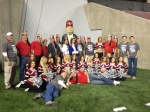 The Spokane Shriners Hospital has 5 floors. The 5th floor houses the OR and administrative offices like finance and performance improvement. The 4th and 3rd floors are home to patient care areas such as OPC, inpatient, rec therapy, social work, and nutrition. From the 5th floor all the way down to the 1st floor with security and environmental services, all the staff had a singular experience, a singular unifying force. This force was a 7-year-old boy from Gaza who stayed as a patient receiving prosthetic legs. His name was Wesseem, and “force” is an understatement.
The Spokane Shriners Hospital has 5 floors. The 5th floor houses the OR and administrative offices like finance and performance improvement. The 4th and 3rd floors are home to patient care areas such as OPC, inpatient, rec therapy, social work, and nutrition. From the 5th floor all the way down to the 1st floor with security and environmental services, all the staff had a singular experience, a singular unifying force. This force was a 7-year-old boy from Gaza who stayed as a patient receiving prosthetic legs. His name was Wesseem, and “force” is an understatement.
 Wesseem was born with a condition known as bilateral tibial hemimlia, a condition causing a malformation in his lower legs. Arrangements were made by the Washington State chapter of the Palestinian Children’s Relief Fund, a non-profit organization created “to address the medical and humanitarian crisis facing Palestinian youths in the Middle East.” Working with the care management team at the Spokane Shriners Hospital, arrangements were made to bring Wesseem and his mother, Sadia from their home in Gaza to Spokane with the goal of giving the young boy the ability to walk.
Wesseem was born with a condition known as bilateral tibial hemimlia, a condition causing a malformation in his lower legs. Arrangements were made by the Washington State chapter of the Palestinian Children’s Relief Fund, a non-profit organization created “to address the medical and humanitarian crisis facing Palestinian youths in the Middle East.” Working with the care management team at the Spokane Shriners Hospital, arrangements were made to bring Wesseem and his mother, Sadia from their home in Gaza to Spokane with the goal of giving the young boy the ability to walk.
 When mother and son arrived in Spokane, neither spoke a single word of English. As Wesseem recovered from the bilateral amputation surgery to prepare his legs to fit into custom prosthetics, the staff (nurses and security guards alike) took to teaching the lad English words and phrases. Soon his legs were healed enough to fit into his first pair of prosthetics. As Wesseem’s coordination improved, so did his English. His world expanded at the same rate as his vocabulary. Neither could keep pace, however, with the growth of his confidence. It wasn’t long before the entire hospital was introduced to a personality that would leave its mark long after he was reunited with his father and three siblings in Gaza.
When mother and son arrived in Spokane, neither spoke a single word of English. As Wesseem recovered from the bilateral amputation surgery to prepare his legs to fit into custom prosthetics, the staff (nurses and security guards alike) took to teaching the lad English words and phrases. Soon his legs were healed enough to fit into his first pair of prosthetics. As Wesseem’s coordination improved, so did his English. His world expanded at the same rate as his vocabulary. Neither could keep pace, however, with the growth of his confidence. It wasn’t long before the entire hospital was introduced to a personality that would leave its mark long after he was reunited with his father and three siblings in Gaza.
 With an open floor plan from ground to 5th floor, the voice they would all come to know could be heard from anywhere in the hospital. At any point, anyone could know where he was just by listening. He raced his physical therapists down the halls, narrowly missing a nurse walking out of a room. She would smile affectionately as he sped away on his wheelchair at first…then a walker, then crutches and finally on his prosthetics without any help! Wesseem was nearing his dream of walking; of playing soccer with his friends.
With an open floor plan from ground to 5th floor, the voice they would all come to know could be heard from anywhere in the hospital. At any point, anyone could know where he was just by listening. He raced his physical therapists down the halls, narrowly missing a nurse walking out of a room. She would smile affectionately as he sped away on his wheelchair at first…then a walker, then crutches and finally on his prosthetics without any help! Wesseem was nearing his dream of walking; of playing soccer with his friends.
Wesseem didn’t know was that as he was racing he was also learning. As he walked down to the security desk, only to call someone from the 5th floor to bring him water, he was growing in skill and strength. Finally, he was ready. He had made new friends, nay, family and learned a new language. He learned to walk. Staff watched Wesseem walk out the front doors. Then, they did what they always do. They wiped away bittersweet tears of joy and pride and turned back to the inpatient rooms ready to give their hearts to the next child, just now checking in.
to the security desk, only to call someone from the 5th floor to bring him water, he was growing in skill and strength. Finally, he was ready. He had made new friends, nay, family and learned a new language. He learned to walk. Staff watched Wesseem walk out the front doors. Then, they did what they always do. They wiped away bittersweet tears of joy and pride and turned back to the inpatient rooms ready to give their hearts to the next child, just now checking in.






